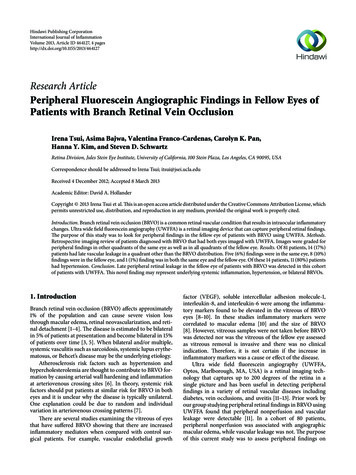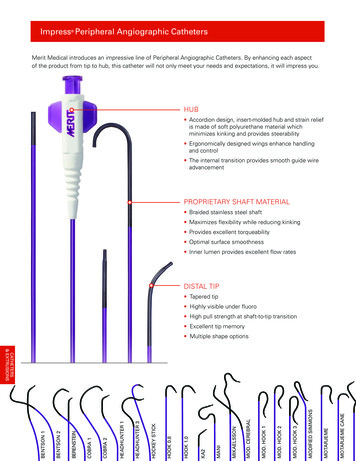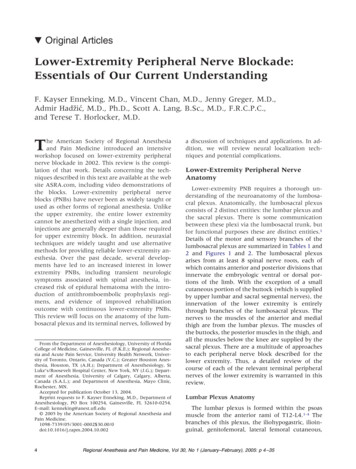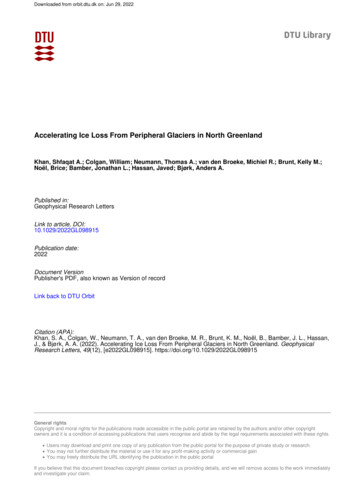
Transcription
Hindawi Publishing CorporationInternational Journal of InflammationVolume 2013, Article ID 464127, 4 pageshttp://dx.doi.org/10.1155/2013/464127Research ArticlePeripheral Fluorescein Angiographic Findings in Fellow Eyes ofPatients with Branch Retinal Vein OcclusionIrena Tsui, Asima Bajwa, Valentina Franco-Cardenas, Carolyn K. Pan,Hanna Y. Kim, and Steven D. SchwartzRetina Division, Jules Stein Eye Institute, University of California, 100 Stein Plaza, Los Angeles, CA 90095, USACorrespondence should be addressed to Irena Tsui; itsui@jsei.ucla.eduReceived 4 December 2012; Accepted 8 March 2013Academic Editor: David A. HollanderCopyright 2013 Irena Tsui et al. This is an open access article distributed under the Creative Commons Attribution License, whichpermits unrestricted use, distribution, and reproduction in any medium, provided the original work is properly cited.Introduction. Branch retinal vein occlusion (BRVO) is a common retinal vascular condition that results in intraocular inflammatorychanges. Ultra wide field fluorescein angiography (UWFFA) is a retinal imaging device that can capture peripheral retinal findings.The purpose of this study was to look for peripheral findings in the fellow eye of patients with BRVO using UWFFA. Methods.Retrospective imaging review of patients diagnosed with BRVO that had both eyes imaged with UWFFA. Images were graded forperipheral findings in other quadrants of the same eye as well as in all quadrants of the fellow eye. Results. Of 81 patients, 14 (17%)patients had late vascular leakage in a quadrant other than the BRVO distribution. Five (6%) findings were in the same eye, 8 (10%)findings were in the fellow eye, and 1 (1%) finding was in both the same eye and the fellow eye. Of these 14 patients, 11 (80%) patientshad hypertension. Conclusion. Late peripheral retinal leakage in the fellow eye of patients with BRVO was detected in this cohortof patients with UWFFA. This novel finding may represent underlying systemic inflammation, hypertension, or bilateral BRVOs.1. IntroductionBranch retinal vein occlusion (BRVO) affects approximately1% of the population and can cause severe vision lossthrough macular edema, retinal neovascularization, and retinal detachment [1–4]. The disease is estimated to be bilateralin 5% of patients at presentation and become bilateral in 15%of patients over time [3, 5]. When bilateral and/or multiple,systemic vasculitis such as sarcoidosis, systemic lupus erythematosus, or Behcet’s disease may be the underlying etiology.Atherosclerosis risk factors such as hypertension andhypercholesterolemia are thought to contribute to BRVO formation by causing arterial wall hardening and inflammationat arteriovenous crossing sites [6]. In theory, systemic riskfactors should put patients at similar risk for BRVO in botheyes and it is unclear why the disease is typically unilateral.One explanation could be due to random and individualvariation in arteriovenous crossing patterns [7].There are several studies examining the vitreous of eyesthat have suffered BRVO showing that there are increasedinflammatory mediators when compared with control surgical patients. For example, vascular endothelial growthfactor (VEGF), soluble intercellular adhesion molecule-1,interleukin-8, and interleukin-6 were among the inflammatory markers found to be elevated in the vitreous of BRVOeyes [8–10]. In these studies inflammatory markers werecorrelated to macular edema [10] and the size of BRVO[8]. However, vitreous samples were not taken before BRVOwas detected nor was the vitreous of the fellow eye assessedas vitreous removal is invasive and there was no clinicalindication. Therefore, it is not certain if the increase ininflammatory markers was a cause or effect of the disease.Ultra wide field fluorescein angiography (UWFFA,Optos, Marlborough, MA, USA) is a retinal imaging technology that captures up to 200 degrees of the retina in asingle picture and has been useful in detecting peripheralfindings in a variety of retinal vascular diseases includingdiabetes, vein occlusions, and uveitis [11–13]. Prior work byour group studying peripheral retinal findings in BRVO usingUWFFA found that peripheral nonperfusion and vascularleakage were detectable [11]. In a cohort of 80 patients,peripheral nonperfusion was associated with angiographicmacular edema, while vascular leakage was not. The purposeof this current study was to assess peripheral findings on
2International Journal of Inflammation(a)Figure 1: Ultra wide field fluorescein angiogram of an eye witha superotemporal branch retinal vein occlusion. There is also lateperipheral leakage in the inferotemporal quadrant.fluorescein angiography in other quadrants of the same eyeand in fellow eyes of patients with BRVO.2. Materials and MethodsThis retrospective imaging study was Institutional ReviewBoard approved and carried out at the Jules Stein Eye Institutein Los Angles, CA, USA. An imaging database was searchedfor patients with the diagnosis of BRVO who underwentUWFFA (Optos, Marlborough, MA, USA). Patients withanother diagnosis or with concurrent other retinal diseases (i.e., age-related macular degeneration) were excluded.Patients with poorly controlled diabetes or signs of diabeticretinopathy such as intraretinal hemorrhage and venousbeading were excluded. Patients with known inflammatorydisorders such as sarcoidosis, systemic lupus erythematosus,and Behcet’s disease were excluded.Demographic data such as patient gender and age werecollected. Significant past medical history such as hypertension, high cholesterol, and diabetes mellitus were noted. Allimages were reviewed with Vantage Review Software (Optos,Marlborough, MA, USA) and adjusted with zoom, gamma,and contrast to optimize image quality. The quadrant affectedby a BRVO was recorded. Other quadrants of the same eyewere assessed for peripheral findings. Similarly, all quadrantsof the fellow eye were graded for peripheral findings.3. ResultsA total of 84 patients with BRVO were included in this study.Forty-nine (58%) patients were female and 55 (65%) eyes wereOD. Average patient age was 60 years old (range 34–94 years;SD 13 years). Sixteen (19%) patients had no significant pastmedical history. Thirty-eight (45%) patients had hypertension only. Nineteen (23%) patients had hypertension and highcholesterol only. Five (6%) patients had hypertension anddiabetes mellitus only. Four (5%) patients had hypertension,high cholesterol, and diabetes mellitus. Two (2%) patients haddiabetes mellitus only.Thirteen (15%) BRVOs were macular and 71 (85%) werequadrantic. Of the macular BRVOs, 10 (77%) were superior(b)Figure 2: (a) Ultra wide field angiogram of a patient with branchretinal vein occlusion in the right eye. (b) The fellow eye has lateperipheral leakage temporally.and 3 (23%) were inferior. Of the quadrantic BRVOs, 40(56%) were superotemporal, 25 (35%) were inferotemporal, 3(4%) were inferonasal, and 1 (1%) was superonasal. Two (3%)patients had two quadrantic BRVOs in the same eye.Three (4%) patients were known to have bilateral BRVOsat the time of presentation. Of the remaining 81 patients, 14(17%) patients had late vascular leakage in a quadrant otherthan the BRVO distribution. Five (6%) findings were in thesame eye, 8 (10%) findings were in the fellow eye, and 1 (1%)finding was in both the same eye and the fellow eye. The sixeyes (7%) with leakage in the same eye all had leakage in aquadrant contiguous to the BRVO. Of the 14 patients withleakage in a quadrant other than the BRVO, 8 (57%) patientshad hypertension only; 2 (14%) patients had hypertension,high cholesterol, and diabetes mellitus; 1 (7%) patient hadhypertension and diabetes mellitus only; 1 (7%) patient hadhigh cholesterol only; and 2 (14%) patients had no knownsystemic diseases.4. DiscussionThis study examined peripheral retinal changes in patientswith BRVO in other quadrants of the same eye and in thefellow eye using UWFFA. In 81 patients, 14 (17%) patientshad late vascular leakage in a quadrant other than the BRVOdistribution. Two examples from our study are shown inFigures 1 and 2.
International Journal of InflammationThere are three explanations for detecting late peripheralleakage in 11% (𝑛 9) of fellow eyes. One possibilityis that inflammation is not only a consequence of veinocclusion, but it is also a part of the pathogenesis of BRVOand patients with BRVO have higher levels of inflammationsystemically. This hypothesis has been tested by examininggene polymorphisms related to inflammatory cytokines inBRVO patients and normal control patients [14]. In a studyof almost 400 patients, 10 single nucleotide polymorphismswere assayed but were not found to be independent riskfactors for BRVO suggesting that inflammation did notcontribute to the pathogenesis of BRVO.A multiethnic epidemiological study of over 6000 subjects considered the association of retinal vein occlusion(RVO) to traditional cardiovascular risk factors [1]. RVO wasnot associated with systemic inflammation, hematologicalabnormalities, or atherosclerosis but it was associated withhypertension and dyslipidemia. Given the high prevalence ofhypertension in our group of patients, a second explanationfor late peripheral leakage in the fellow eye is that it was amanifestation of hypertension.A third explanation of bilateral leakage is that BRVO maybe underrecognized as a bilateral disease and these areas oflate peripheral leakage are actually small peripheral BRVOsthat are otherwise undetectable with clinical exam andtraditional imaging. This would be supported by the fact thatthe distribution of leakage was often in a venous distribution.Without coexisting macular edema or peripheral ischemia,small incidentally found BRVOs do not require treatmentbut the finding does warrant further observation to detectprogression of disease.Lastly, it is possible that these small areas of peripheralvascular leakage are not pathological and may be found in thegeneral population. To our knowledge, there is no prior studyestablishing UWFFA findings in healthy patients withoutknown ocular or systemic disease. In 1985, a study usingtraditional fluorescein angiography in 25 patients did notdetect peripheral leakage in normal patients [15]. However,this was before UWFFA was available and likely incompletelycaptured the periphery.Limitations of our study are related to its retrospectivenature, sample size, and lack of a control group. Some patientshad anti-VEGF treatment within two months of havingUWFFA and this may have masked leakage in the treatedeye. It is possible that patients with unexpected peripheralleakage do in fact have a coexisting systemic illness thatwas not documented in the chart. Furthermore, patientsat a tertiary referral center may not represent the generalpopulation. Nonetheless, a subset of patients were foundto have unexpected late peripheral leakage on UWFFA ofpossible clinical significance.In conclusion, 11% of patients with BRVO in our population had unexpected late peripheral leakage in fellow eyeson UWFFA. It may represent an underlying inflammatorycondition, hypertensive changes, or bilateral BRVO. Furtherstudies to evaluate a larger population of BRVO patients ina protocol manner should be considered to further elucidatethe significance of these findings.3Conflict of InterestsAuthors have no conflict of interests to declare.AcknowledgmentThis work was presented in part in a meeting at the Association for Research and Vision in Ophthalmology, FortLauderdale, FL, USA; May 2012.References[1] N. Cheung, R. Klein, J. J. Wang et al., “Traditional and novelcardiovascular risk factors for retinal vein occlusion: the multiethnic study of atherosclerosis,” Investigative Ophthalmologyand Visual Science, vol. 49, no. 10, pp. 4297–4302, 2008.[2] J. P. Ehlers and S. Fekrat, “Retinal vein occlusion: beyond theacute event,” Survey of Ophthalmology, vol. 56, no. 4, pp. 281–299, 2011.[3] S. L. Rogers, R. L. McIntosh, L. Lim et al., “Natural historyof branch retinal vein occlusion: an evidence-based systematicreview,” Ophthalmology, vol. 117, no. 6, pp. 1094.e5–1101.e5, 2010.[4] R. Klein, S. E. Moss, S. M. Meuer, and B. E. K. Klein, “The 15year cumulative incidence of retinal vein occlusion: the BeaverDam Eye Study,” Archives of Ophthalmology, vol. 126, no. 4, pp.513–518, 2008.[5] S. S. Hayreh, P. A. Podhajsky, and M. B. Zimmerman, “Branchretinal artery occlusion. natural history of visual outcome,”Ophthalmology, vol. 116, no. 6, pp. 1188.e4–1194.e4, 2009.[6] P. R. A. O’Mahoney, D. T. Wong, and J. G. Ray, “Retinalvein occlusion and traditional risk factors for atherosclerosis,”Archives of Ophthalmology, vol. 126, no. 5, pp. 692–699, 2008.[7] D. V. Weinberg, K. M. Egan, and J. M. Seddon, “Asymmetricdistribution of arteriovenous crossings in the normal retina,”Ophthalmology, vol. 100, no. 1, pp. 31–36, 1993.[8] H. Noma, H. Funatsu, T. Mimura, S. Eguchi, and K. Shimada :,“Inflammatory factors in major and macular branch retinal veinocclusion,” Ophthalmologica, vol. 227, no. 3, pp. 146–152, 2012.[9] T. Yoshimura, K. H. Sonoda, M. Sugahara et al., “Comprehensive analysis of inflammatory immune mediators in vitreoretinal diseases,” PLoS ONE, vol. 4, no. 12, Article ID e8158, 2009.[10] Y. Okunuki, Y. Usui, N. Katai et al., “Relation of intraocularconcentrations of inflammatory factors and improvement ofmacular edema after vitrectomy in branch retinal vein occlusion,” The American Journal of Ophthalmology, vol. 151, no. 4,pp. 610.e1–616.e1, 2011.[11] P. S. Prasad, S. C. N. Oliver, R. E. Coffee, J. P. Hubschman, andS. D. Schwartz, “Ultra Wide-Field Angiographic Characteristicsof Branch Retinal and Hemicentral Retinal Vein Occlusion,”Ophthalmology, vol. 117, no. 4, pp. 780–784, 2010.[12] S. C. N. Oliver and S. D. Schwartz, “Peripheral vessel leakage(PVL): a new angiographic finding in diabetic retinopathy identified with ultra wide-field fluorescein angiography,” Seminars inOphthalmology, vol. 25, no. 1-2, pp. 27–33, 2010.[13] I. Tsui, A. Kaines, and S. Schwartz, “Patterns of periphlebitis inintermediate uveitis using ultra wide field fluorescein angiography,” Seminars in Ophthalmology, vol. 24, no. 1, pp. 29–33, 2009.[14] I. Steinbrugger, A. Haas, R. Maier et al., “Analysis of inflammation- and atherosclerosis-related gene polymorphisms inbranch retinal vein occlusion,” Molecular Vision, vol. 15, pp.609–618, 2009.
4[15] H. J. Zenker, “Fluorescein angiography in inflammation of theperipheral fundus: the normal fluorescein angiographic pattern.I,” Ophthalmologica, vol. 190, no. 2, pp. 77–82, 1985.International Journal of Inflammation
MEDIATORSofINFLAMMATIONThe ScientificWorld JournalHindawi Publishing Corporationhttp://www.hindawi.comVolume 2014GastroenterologyResearch and PracticeHindawi Publishing Corporationhttp://www.hindawi.comVolume 2014Journal ofHindawi Publishing Corporationhttp://www.hindawi.comDiabetes ResearchVolume 2014Hindawi Publishing Corporationhttp://www.hindawi.comVolume 2014Hindawi Publishing Corporationhttp://www.hindawi.comVolume 2014International Journal ofJournal ofEndocrinologyImmunology ResearchHindawi Publishing Corporationhttp://www.hindawi.comDisease MarkersHindawi Publishing Corporationhttp://www.hindawi.comVolume 2014Volume 2014Submit your manuscripts athttp://www.hindawi.comBioMedResearch InternationalPPAR ResearchHindawi Publishing Corporationhttp://www.hindawi.comHindawi Publishing Corporationhttp://www.hindawi.comVolume 2014Volume 2014Journal ofObesityJournal ofOphthalmologyHindawi Publishing Corporationhttp://www.hindawi.comVolume 2014Evidence-BasedComplementary andAlternative MedicineStem CellsInternationalHindawi Publishing Corporationhttp://www.hindawi.comVolume 2014Hindawi Publishing Corporationhttp://www.hindawi.comVolume 2014Journal ofOncologyHindawi Publishing Corporationhttp://www.hindawi.comVolume 2014Hindawi Publishing Corporationhttp://www.hindawi.comVolume 2014Parkinson’sDiseaseComputational andMathematical Methodsin MedicineHindawi Publishing Corporationhttp://www.hindawi.comVolume 2014AIDSBehaviouralNeurologyHindawi Publishing Corporationhttp://www.hindawi.comResearch and TreatmentVolume 2014Hindawi Publishing Corporationhttp://www.hindawi.comVolume 2014Hindawi Publishing Corporationhttp://www.hindawi.comVolume 2014Oxidative Medicine andCellular LongevityHindawi Publishing Corporationhttp://www.hindawi.comVolume 2014
Retina Division, Jules Stein Eye Institute, University of California, Stein Plaza, Los Angeles, CA , USA . nding was in both the same eye and the fellow eye. e six eyes ( %) with leakage in the same eye all had leakage in a quadrant contiguous to the BRVO. Of the patients with










